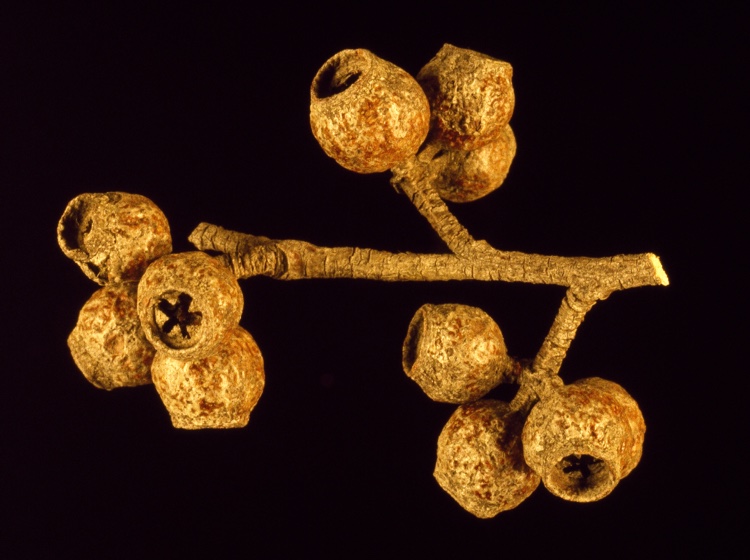Eucalyptus Fraxinoides on:
[Wikipedia]
[Google]
[Amazon]
''Eucalyptus fraxinoides'', commonly known as the white ash or white mountain ash, is a medium-sized to tall tree of mountain country and is endemic to south eastern Australia. It has rough, compacted greyish bark on the lower trunk, smooth white bark with scribbles above, lance-shaped adult leaves, flower buds in groups of between seven and eleven, white flowers and barrel-shaped or urn-shaped fruit.




Description
''Eucalyptus fraxinoides'' is a tree that typically grows to a height of and forms a lignotuber. It has rough, greyish, short fibrous bark on the lower trunk, smooth white, grey or yellow bark with insect scribbles above. Young plants and coppice regrowth have sessile, elliptic to egg-shaped to lance-shaped or curved leaves that are long and wide. Adult leaves are lance-shaped or curved, long and wide on a petiole wide. The flower buds are arranged in leafaxil
A leaf ( : leaves) is any of the principal appendages of a vascular plant stem, usually borne laterally aboveground and specialized for photosynthesis. Leaves are collectively called foliage, as in "autumn foliage", while the leaves, st ...
s in groups of seven, nine or eleven on an unbranched peduncle Peduncle may refer to:
*Peduncle (botany), a stalk supporting an inflorescence, which is the part of the shoot of seed plants where flowers are formed
*Peduncle (anatomy), a stem, through which a mass of tissue is attached to a body
**Peduncle (art ...
long, the individual buds on pedicels
In botany, a pedicel is a stem that attaches a single flower to the inflorescence. Such inflorescences are described as ''pedicellate''.
Description
Pedicel refers to a structure connecting a single flower to its inflorescence. In the absenc ...
long. Mature buds are oval, long and wide with a conical to rounded operculum. Flowering occurs from December to February and the flowers are white. The fruit is a woody, barrel-shaped or urn-shaped capsule long and wide.Brooker, I. & Kleinig, D., ''Eucalyptus, An illustrated guide to identification'', Reed Books, Melbourne, 1996
Taxonomy and naming
''Eucalyptus fraxinoides'' was first formally described in 1898 by Henry Deane and Joseph Maiden from specimens they collected with William Bäuerlen on Tantawangalo Mountain near Cathcart. The description was published in ''Proceedings of the Linnean Society of New South Wales
The Linnean Society of New South Wales promotes ''the Cultivation and Study of the Science of Natural History in all its Branches'' and was founded in Sydney, New South Wales ( Australia) in 1874 and incorporated in 1884.
History
The Society suc ...
''. The specific epithet
In taxonomy, binomial nomenclature ("two-term naming system"), also called nomenclature ("two-name naming system") or binary nomenclature, is a formal system of naming species of living things by giving each a name composed of two parts, bot ...
(''fraxinoides'') refers to a perceived similarity to trees in the genus ''Fraxinus
''Fraxinus'' (), common name, commonly called ash, is a genus of flowering plants in the olive and lilac family, Oleaceae. It contains 45–65 species of usually medium to large trees, mostly deciduous, though a number of Subtropics, subtropic ...
''. (The suffix
In linguistics, a suffix is an affix which is placed after the stem of a word. Common examples are case endings, which indicate the grammatical case of nouns, adjectives, and verb endings, which form the conjugation of verbs. Suffixes can carry ...
''-oides'' means "likeness" in Latin.) '' Fraxinus americana'' is also known as white ash.
Distribution and habitat
White ash grows in cool, moist forest on mountain ranges near the coast and on the tablelands of southern New South Wales and far north-eastern Victoria where it often grows in pure stands. In New South Wales it is found south from Sassafras nearTianjara
Tianjara is a locality in the City of Shoalhaven in New South Wales, Australia. It lies generally south of the Braidwood Road between Nowra and Nerriga. It is about 47 kilometres southwest of Nowra. Tianjara is fairly rugged sandstone country and ...
and in Victoria it is confined to the Howe Range near Mallacoota
Mallacoota is a small town in the East Gippsland region in the state of Victoria, Australia. At the 2016 census, Mallacoota had a population of 1,063. At holiday times, particularly Easter and Christmas, the population increases by about 8,000 ...
.
References
{{Taxonbar, from=Q3024379 fraxinoides Myrtales of Australia Flora of New South Wales Flora of Victoria (state) Plants described in 1898 Taxa named by Henry Deane (engineer) Taxa named by Joseph Maiden